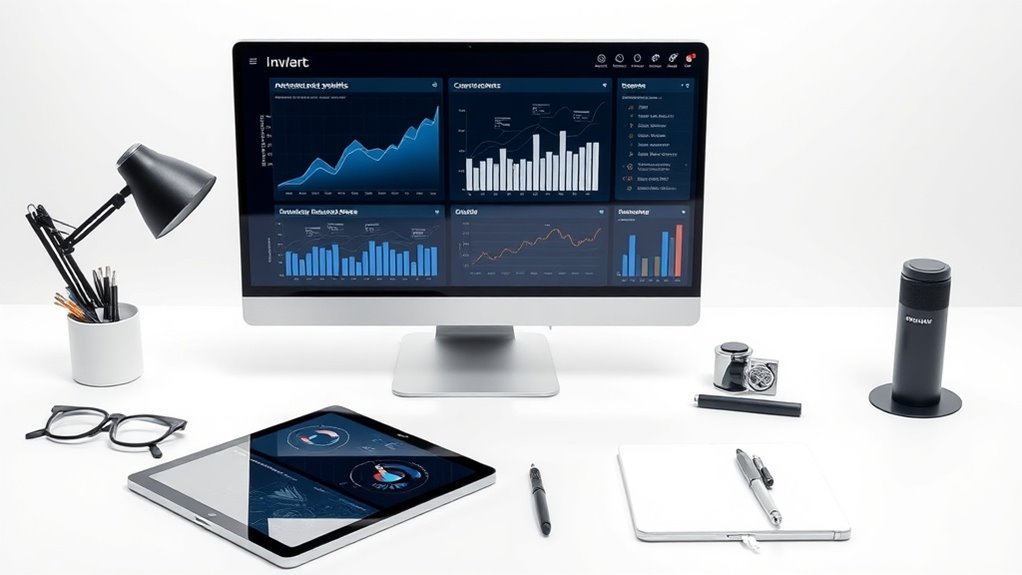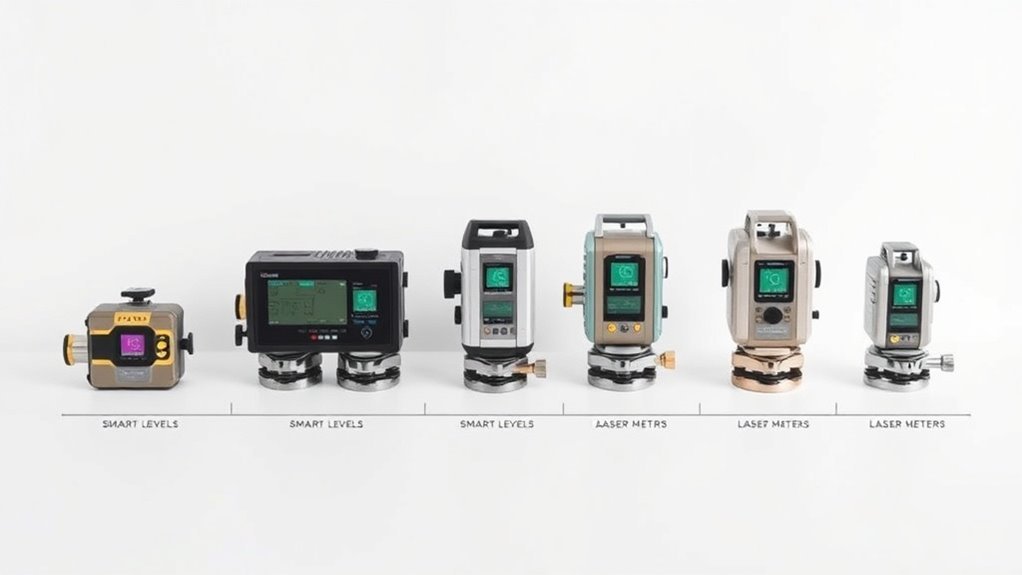Data Accuracy: How Smart Tools Ensure Precision

Smart tools guarantee data accuracy by automating collection and validation processes, minimizing human error. They use real-time monitoring to catch discrepancies immediately and employ machine learning to identify patterns and flag inconsistencies. These innovations not only streamline your operations but also enhance decision-making by providing reliable insights. By investing in these technologies, you can boost your organization’s efficiency and trust in its data. There’s so much more to explore about these smart solutions and their impact.
Key Takeaways
- Smart tools automate data collection and validation, significantly reducing human errors and enhancing data accuracy.
- Machine learning algorithms analyze data patterns and flag anomalies, ensuring only high-quality data is maintained.
- Real-time monitoring solutions provide immediate alerts for discrepancies, allowing for swift corrective actions.
- Cloud-based platforms offer scalable solutions for maintaining data integrity and accessibility across teams.
- Regular audits and training on effective data management practices foster a culture prioritizing data accuracy.
The Importance of Data Accuracy in Business
In today’s data-driven world, accuracy isn’t just a nice-to-have; it’s a necessity for businesses. You rely on precise data to make informed decisions, drive strategies, and enhance customer satisfaction.
When your data is accurate, you can identify trends, forecast future performance, and streamline operations effectively. Additionally, stakeholders trust your insights more, which can lead to stronger partnerships and increased investment opportunities.
Accurate data also helps prevent costly errors that can damage your reputation and finances. By prioritizing data accuracy, you not only boost your organization’s efficiency but also maintain a competitive edge in your industry. Furthermore, leveraging smart tools can significantly enhance the process of collecting and analyzing data, leading to even greater precision.
Ultimately, investing in reliable data management tools makes all the difference in achieving your business goals. So, don’t underestimate the power of precision.
Challenges in Maintaining Data Integrity

Maintaining data integrity isn’t easy, especially when human error is always a risk.
You also have to grapple with the reliability of your data sources, which can vary markedly.
Let’s explore how these challenges can impact your overall data accuracy.
Human Error Risks
When people handle data, the risk of human error often compromises its integrity.
You’ll find that mistakes can happen during data entry, analysis, or interpretation, leading to inaccurate conclusions. Missed digits, typos, and even poor communication can distort the data you’re working with.
It’s easy to overlook small details, but these little errors can snowball into significant problems over time. You’re also at risk of cognitive biases, which may cloud your judgment when evaluating data significance.
To maintain the highest standards of accuracy, it’s crucial to implement double-checking systems and to encourage a culture where team members can openly discuss data-related challenges.
Data Source Reliability
Data source reliability is one of the biggest challenges in ensuring data integrity. If you’re relying on inaccurate or outdated sources, the decisions you make based on that data can be flawed. One way to tackle this issue is by regularly evaluating and validating data sources. Here’s a quick overview of common reliability factors:
| Factor | Considerations |
|---|---|
| Source Reputation | Is it reputable and trustworthy? |
| Data Timeliness | Is the data updated regularly? |
| Accuracy and Precision | How precise is the information? |
| User Feedback | What do others say about it? |
The Role of Automation in Data Collection

Although many organizations rely on manual processes for data collection, automation has become a game changer in enhancing accuracy and efficiency.
With automated tools, you can streamline data gathering, minimizing human error and inconsistencies. These smart systems can gather vast amounts of information from various sources in real-time, ensuring you have up-to-date data at your fingertips.
Plus, automation speeds up the entire process, allowing your team to focus on analysis rather than tedious data entry. By implementing automated solutions, you not only save time and resources but also improve overall data integrity. Furthermore, using smart technology in your tools allows for enhanced data accuracy and connectivity, making your processes even more efficient.
This shift towards automation equips you with greater confidence in your decisions, leading to more informed strategies and successful outcomes. Your data collection efforts become smarter, faster, and more reliable.
Leveraging Machine Learning for Data Validation
As organizations aim for greater accuracy, leveraging machine learning for data validation offers a powerful solution. By using algorithms to analyze patterns and detect anomalies, you can enhance your data’s reliability considerably.
These tools learn from historical data, identifying what constitutes normal behavior and flagging any discrepancies that arise. With machine learning, you don’t just automate the validation process; you also improve it over time.
You can quickly filter out invalid entries, ensuring only high-quality data remains in your systems. Furthermore, machine learning algorithms adapt as your data sets evolve, keeping your validation efforts effective and relevant.
Embracing this technology means you can focus on decision-making while trusting that your data is accurate and reliable.
Real-Time Monitoring: Enhancing Data Reliability
To guarantee data reliability, implementing real-time monitoring systems can be a game-changer for organizations. These systems allow you to track data continuously, ensuring its accuracy and consistency.
You’ll receive immediate alerts for any discrepancies or anomalies, enabling quick intervention before minor issues escalate. With real-time insights, you’re not just reacting; you’re proactively preserving the integrity of your data. Additionally, integrating Bluetooth and app features into monitoring tools can significantly enhance connectivity and functionality.
Enhanced visibility into data flows means you can easily identify trends and operational inefficiencies as they arise. Furthermore, real-time monitoring fosters a culture of accountability, encouraging your team to maintain high standards in data management.
Case Studies of Successful Smart Tool Implementation
Now that you’ve seen how real-time monitoring enhances data reliability, let’s look at some real-world examples of successful smart tool implementation.
These case studies not only showcase innovative solutions but also highlight measurable impact metrics that demonstrate their effectiveness.
For example, many industries utilize laser measuring tools to revolutionize their data collection processes, showcasing how these tools can drive positive change and improve data accuracy in various sectors.
Real-World Examples
Numerous organizations have successfully implemented smart tools to enhance data accuracy, showcasing the transformative power of technology in real-world scenarios.
For instance, companies have embraced AI-driven analytics platforms to streamline their processes, reduce errors, and improve decision-making.
These implementations have delivered remarkable results, including:
- Increased customer satisfaction through accurate order processing
- Enhanced compliance by accurately tracking regulatory requirements
- Minimized operational risks by identifying potential inconsistencies
- Boosted employee morale as a result of streamlined operations
- Strengthened brand reputation due to trustworthy data insights
Measurable Impact Metrics
The successful implementation of smart tools not only enhances data accuracy but also provides measurable impact metrics that underscore their effectiveness. For instance, companies using smart analytics reported a 30% reduction in errors and a 25% increase in efficiency. To illustrate, look at these compelling metrics from various case studies:
| Company | Metric Improved |
|---|---|
| TechCorp | 20% faster data processing |
| DataWise | 15% increase in data quality |
| InfoSecure | 40% reduction in fraud cases |
| SmartRetail | 30% higher sales accuracy |
| HealthPlus | 25% enhanced patient data reliability |
These examples showcase how smart tools lead to significant improvements that can’t be ignored, encouraging more organizations to adopt them for better results.
The Impact of Data Accuracy on Decision-Making
When data isn’t accurate, it can lead you down the wrong path in decision-making.
You might find yourself making choices that negatively affect your projects, team, or even your company’s future. Poor data can instill fear and uncertainty, overshadowing your confidence.
Here are some potential impacts:
- You’ll waste time and resources on misguided strategies.
- Team morale can drop when mistakes occur due to bad data.
- Critical opportunities may be missed, stifling growth.
- Trust in data-handling processes can erode.
- Reputation damage can occur from poor outcomes, affecting customer relationships.
Inaccurate data isn’t just a number; it can alter the trajectory of your decisions and, ultimately, your success.
Ensuring data accuracy is essential for clarity in your decision-making journey.
Future Trends in Data Accuracy Solutions
As businesses increasingly rely on data-driven strategies, innovative solutions for ensuring data accuracy are emerging to meet growing demands.
You’re likely to see a rise in AI-driven tools that automate data validation and cleaning, considerably reducing manual errors. Machine learning algorithms will adapt to changing data patterns, ensuring smarter accuracy over time.
A surge in AI tools will automate data cleaning, minimizing errors and enhancing accuracy through adaptive machine learning algorithms.
Real-time data monitoring solutions will become essential, allowing immediate corrections to discrepancies, thereby enhancing decision-making processes. Additionally, you can expect an emphasis on user-friendly interfaces, making it easier for teams to input, manage, and interpret data.
Finally, cloud-based platforms will continue to grow, offering scalable solutions that integrate seamlessly with existing systems, ensuring your organization stays ahead in maintaining data integrity.
Best Practices for Ensuring Data Precision
Implementing best practices for ensuring data precision is essential as businesses increasingly adopt advanced technologies for data management.
By focusing on a few key strategies, you can enhance your data accuracy and boost your organization’s credibility.
- Regularly audit your data for inconsistencies and errors.
- Train your team on effective data entry techniques to minimize mistakes.
- Utilize automated tools to streamline data processing.
- Establish clear protocols for data governance and management.
- Foster a culture of accountability where team members prioritize data integrity.
Questions
What Is the Cost of Implementing Smart Tools for Data Accuracy?
The cost of implementing smart tools for data accuracy varies widely, typically ranging from a few thousand to several hundred thousand dollars. It depends on the tool’s complexity and your organization’s specific needs and size.
How Do Smart Tools Integrate With Existing Systems?
Integrating smart tools with existing systems is like fitting a puzzle piece; they seamlessly connect to enhance functionality. You’ll find that they adapt easily, streamlining processes and improving data handling across your organization.
Can Small Businesses Afford Data Accuracy Solutions?
Yes, small businesses can afford data accuracy solutions. Many options are budget-friendly and scalable, allowing you to enhance your operations without breaking the bank. Investing in these tools can ultimately save you time and money.
What Types of Data Can Smart Tools Analyze?
Smart tools can analyze customer behavior data, like how Sarah’s bakery uses tools to track sales trends and preferences. They also examine operational metrics, social media interactions, and inventory levels, delivering insights to enhance decision-making.
How Is User Training Conducted for These Smart Tools?
User training for smart tools typically involves interactive tutorials, instructional videos, and hands-on workshops. You’ll get real-time feedback to enhance your skills, ensuring you understand how to utilize these tools effectively for accurate results.
Conclusion
In the world of business, data accuracy isn’t just a nice-to-have; it’s essential. By embracing smart tools, you’re not just ensuring precision—you’re paving a path to better decision-making. As you navigate the challenges of data integrity, let automation and machine learning be your guiding stars. Ultimately, staying sharp on data practices will empower you to thrive in an ever-evolving landscape. Remember, accurate data is the compass that points you towards success.






